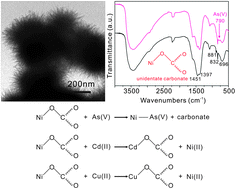Surfactant-free preparation of nickel carbonate hydroxide in aqueous solution and its toxic ion-exchange properties
Abstract
In this paper, we have demonstrated a simple

* Corresponding authors
a
Research Center for Biomimetic Functional Materials and Sensing Devices, Institute of Intelligent Machines, Chinese Academy of Sciences, Hefei 230031, PR China
E-mail:
xingjiuhuang@iim.ac.cn
Fax: +86 551 5592420
Tel: +86 551 5591142
b Department of Pharmacy, Anhui University of Traditional Chinese Medicine, Hefei 230031, PR China
In this paper, we have demonstrated a simple

 Please wait while we load your content...
Something went wrong. Try again?
Please wait while we load your content...
Something went wrong. Try again?
Y. Jia, T. Luo, X. Yu, J. Liu and X. Huang, New J. Chem., 2013, 37, 534 DOI: 10.1039/C2NJ40983F
To request permission to reproduce material from this article, please go to the Copyright Clearance Center request page.
If you are an author contributing to an RSC publication, you do not need to request permission provided correct acknowledgement is given.
If you are the author of this article, you do not need to request permission to reproduce figures and diagrams provided correct acknowledgement is given. If you want to reproduce the whole article in a third-party publication (excluding your thesis/dissertation for which permission is not required) please go to the Copyright Clearance Center request page.
Read more about how to correctly acknowledge RSC content.
 Fetching data from CrossRef.
Fetching data from CrossRef.
This may take some time to load.
Loading related content
